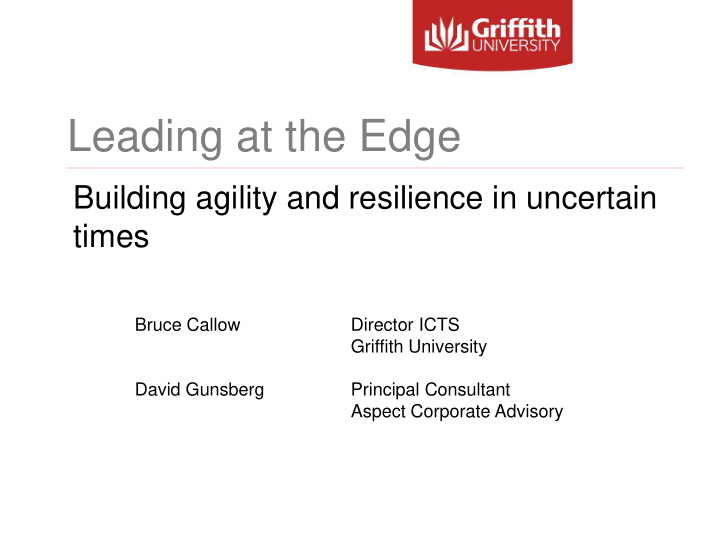



Leading at the Edge Building agility and resilience in uncertain times Bruce Callow Director ICTS Griffith University David Gunsberg Principal Consultant Aspect Corporate Advisory
Bruce Callow Director Information and Communication Technology Services (ICTS) at Griffith University for the past 4 years. Currently the Secretary of the Australian Access Federation and a board member of the Oracle Global Higher Education and Research Strategy Council.
About Griffith University Griffith University opened in 1975 5 campuses across 3 cities (Brisbane, Logan and the Gold Coast) Over 300 degrees available for study over 10 broad study areas : Humanities, Languages and Criminology, Business and Commerce, Education, Engineering and IT, Environment, Planning and Architecture, Health, Law, Music, Science, Visual and Creative Arts Over 43,000 students (domestic and international) Ranked in top 500 universities world wide
Information and Communication Technology Services, Information Services
David Gunsberg Aspect Corporate Advisory Focus on turning strategy into outcomes through excellence in leadership and performance management 5 years working in the Tertiary Education sector 13 years with Fortune 500 firms: » Operational » Major Projects » Sales » Marketing Clients Nationally and Internationally
Change is here and still coming Sector changes » Market and commercial challenges » Portable students, with portable funding Service changes » Importance of student experience » Online v On Campus » Research models » National infrastructure, cloud services Technology changes or challenges » BYOD / BYOA / BYOE » Big data » Global collaboration
How to plan with so much unknown? Plan for what you know Prepare for what you don’t Build agility Build resilience Where? How?
We needed a future proof organisation chart, and here it is
No such thing
What to build? “ Agility is the ability of an organization to sense environmental change and respond efficiently and effectively to that change. “ (Gartner) Enablers of Agility » Awareness - aware of and understand what is going on within and outside of the organisation » Flexibility - ability to react to expected change » Adaptability - react to change that was not expected » Productivity - value contributed through the agility of people, process and technologies
Three areas of focus Agile, resilient technology Agile, resilient processes Agile, resilient people Needed to move fast and with purpose. Also recognised that we may need some external expertise in certain areas.
Technology Utility infrastructure that allows us to allocate processing, storage, and I/O capabilities as needed Enterprise architecture that is practical / developed to the extent that it can support projects and decision making Agile adaptive information systems architecture Access to information is easy while being managed Our information systems are adaptive and can be changed / configured to meet the changing organisational needs
Process Our processes support IT Demand Management Our services are aligned to the operation and services of the organisation and support the delivery of such. Become fully engaged with key business areas and become part of their planning activities. Agile Development Methodologies Process need to be clear and simple - for both clients and staff Metrics on all key services Maturing governance across plan, build and operate
People. Our biggest challenge Having the right people in the right place at the right time to make informed decisions and undertake the tasks Staff are empowered to make decisions and take initiatives. Encourage communication and the open and rapid transfer / availability of knowledge. Career Pathing; IT Capability Review Performance through metrics Alongside the metrics we needed to equip managers with key skills » More than IT » If people skills and people management skills are not where you need them no amount of process or technology can compensate » Partnered with independent consultant to build critical skills over longer term
People Development The Brief: Own the business, understand the business, manage performance, embrace change, communicate vision. Gap analysis » Communication and leadership » General business acumen » Business case writing » Scorecard management » Performance management » Change management Course: “Manager Fundamentals” Now in its third year Nearly 100 IT Leaders and Managers
Manager Fundamentals Course Theme: Be Deliberate. Course Content Benefits Leadership theory Reset expectations Process Management Generated a common language of performance Business case writing Introduced a common, shared toolkit Performance Management of models and methods Change Management Targeted key managers first, quick Communication techniques wins for key areas Strong commercial focus
Manager Fundamentals Based in theory Applied in nature Simple models and tools that work in the every day Strongly positive participant and manager feedback Program culminates in presentations of performance improvement business cases to PVC $2.5m of ideas and benefits realised in last 2 years
Where to from here? Continue to evolve our architecture Evolve our governance Move towards a Lifecycle Management Office (LMO) Continue to grow the capability of our staff Continue with Management Fundamentals NOT IS
In Summary: Three areas of focus. Two we could do ourselves. One we needed help with Agile, resilient technology Agile, resilient processes Agile, resilient people
http://creativecommons.org/licenses/by/4.0/ Questions? OVER TO YOU…
Recommend
More recommend